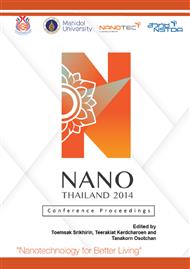[1]
M.L. Rodríguez-Méndez, V. Parra, C. Apetrei, S. Villanueva, M. Gay, N. Prieto, J. Martinez, J.A. de Saja, Electronic tongue based on voltammetric electrodes modified with materials showing complementary electroactive properties. Microcchim. Acta. 163 (2008).
DOI: 10.1007/s00604-007-0907-8
Google Scholar
[2]
A. Legin, A. Rudnitskaya, D. Clapham, B. Seleznev, K. Lord, Y. Vlasov, Electronic tongue for pharmaceutical analytics: quantification of tastes and masking effects, Anal. Bioanal. Chem. 380 (2004) 36-45.
DOI: 10.1007/s00216-004-2738-3
Google Scholar
[3]
D. Kirsanov, O. Zadorozhnaya, A. Krasheninnikov, N. Komarova, A. Popov, A. Legin, Water toxicity evaluation in terms of bioassay with an Electronic Tongue, Sensor. Actuat. B-Chem. 179 (2013) 282-286.
DOI: 10.1016/j.snb.2012.09.106
Google Scholar
[4]
M. del Valle, Sensor Arrays and electronic tongue systems, Int. J. Electrochem. Sci. 2012 (2012) 11.
Google Scholar
[5]
I. Švancara, K. Vytřas, K. Kalcher, A. Walcarius, J. Wang, Carbon paste electrodes in facts, numbers, and notes: a review on the occasion of the 50-years jubilee of carbon paste in electrochemistry and electroanalysis, Electroanalysis. 21 (2009).
DOI: 10.1002/elan.200804340
Google Scholar
[6]
H. Beitollahi, I. Sheikhshoaie, Electrocatalytic oxidation and determination of epinephrine in the presence of uric acid and folic acid at multiwalled carbon nanotubes/molybdenum (vi) complex modified carbon paste electrode, Anal. Methods. 3 (2011).
DOI: 10.1039/c1ay05211j
Google Scholar
[7]
S. Shahrokhian, M. Amiri, Multi-walled carbon nanotube paste electrode for selective voltammetric detection of isoniazid, Microchim. Acta. 157 (2007) 149-158.
DOI: 10.1007/s00604-006-0665-z
Google Scholar
[8]
M.F. Zampa, I.M. d.S. Araújo, J.R. dos Santos Júnior, V. Zucolotto, J.R. d.S.A. Leite, C. Eiras, Development of a novel biosensor using cationic antimicrobial peptide and nickel phthalocyanine ultrathin films for electrochemical detection of dopamine, Int. J. Environ. Anal. Chem. 2012 (2012).
DOI: 10.1155/2012/850969
Google Scholar
[9]
K. Honeychurch, L. Gilbert, J. Hart, Electrocatalytic behaviour of citric acid at a cobalt phthalocyanine-modified screen-printed carbon electrode and its application in pharmaceutical and food analysis, Anal. Bioanal. Chem. 396 (2010) 3103-3111.
DOI: 10.1007/s00216-010-3534-x
Google Scholar
[10]
A. Arrieta, M.L. Rodriguez-Mendez, J.A. de Saja, Langmuir–Blodgett film and carbon paste electrodes based on phthalocyanines as sensing units for taste, Sensor. Actuat. B-Chem. 95 (2003) 357-365.
DOI: 10.1016/s0925-4005(03)00438-6
Google Scholar
[11]
A. Thangprasert, P. Pasitsuparoad, A. Sinsarp, S. Dangtip, T. Osotchan, Electrochemical detection of dopamine by electrostatic self assembly nanostructure electrode of nickel tetrasulfonated phthalocyanine, 13th FAOBMB Congress, 2012, (2012).
Google Scholar
[12]
M. Siswana, K.I. Ozoemena, T. Nyokong, Electrocatalytic behaviour of carbon paste electrode modified with iron (II) phthalocyanine (FePc) nanoparticles towards the detection of amitrole, Talanta. 69 (2006) 1136-1142.
DOI: 10.1016/j.talanta.2005.12.014
Google Scholar
[13]
B. Simic-Glavaski, S. Zecevic, E. Yeager, Spectroscopic and electrochemical studies of transition metal tetrasulfonated phthalocyanines: A correlation between Raman band intensities and oxidation-reduction cycles for adsorbed metal-free and cobalt tetrasulfonated phthalocyanines on silver electrodes, J. Phys. Chem. A. 87 (1983).
DOI: 10.1021/j100246a001
Google Scholar


